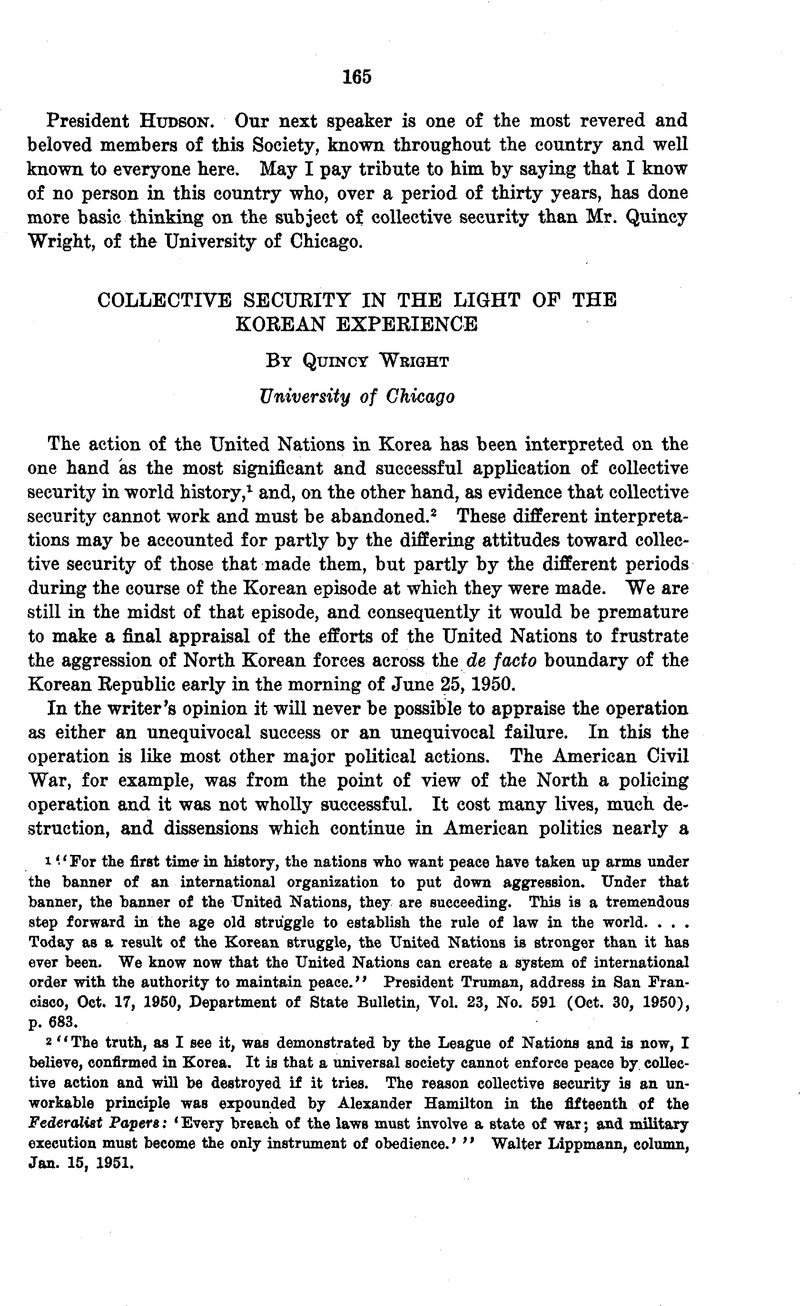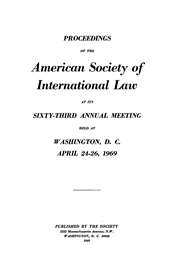No CrossRef data available.
Article contents
Collective Security in the Light of the Korean Experience
Published online by Cambridge University Press: 27 February 2017
Abstract

- Type
- Fifth Session
- Information
- Proceedings of the American Society of International Law at its annual meeting (1921-1969) , Volume 45 , 1951 , pp. 165 - 181
- Copyright
- Copyright © American Society of International Law 1951
References
1 “For the first time in history, the nations who want peace have taken up arms under the banner of an international organization to put down aggression. Under that banner, the banner of the United Nations, they are succeeding. This is a tremendous step forward in the age old struggle to establish the rule of law in the world. . . . Today as a result of the Korean struggle, the United Nations is stronger than it has ever been. We know now that the United Nations can create a system of international order with the authority to maintain peace.” President Truman, address in San Francisco, Oct. 17, 1960, Department of State Bulletin, Vol. 23, No. 591 (Oct. 30, 1950), p. 683.
2 “The truth, as I see it, was demonstrated by the League of Nations and is now, I believe, confirmed in Korea. It is that a universal society cannot enforce peace by collective action and will be destroyed if it tries. The reason collective security is an unworkable principle was expounded by Alexander Hamilton in the fifteenth of the Federalist Papere: ‘Every breach of the laws must involve a state of war; and military execution must become the only instrument of obedience.’” Walter Lippmann, column, Jan. 15, 1951.
3 United Nations Bulletin, Vol. IX, No. 10 (Nov. 15, 1950), pp. 508 ff.
4 The writer has discussed the legal, political, psychological, and technical aspects of collective security in “The Outlawry of War,” American Journal of International Law, Vol. 19 (1925), pp. 96 ff.; “The Present Status of Neutrality,” ibiđ., Vol. 34 (1940), pp. 346 ff.; “Peace and Political Organization,” International Conciliation, April, 1941, No. 369, pp. 454 ff.; “Fundamental Problems of International Organization,” ibid., pp. 468 ff.; A Study of War (Chicago, 1942), pp. 1043-1076; “International Law and the Balance of Power,” American Journal of International Law, Vol. 37 (1943), pp. 97 ff.; “National Security and International Police,” ibid., pp. 502 ff.; “Peace Probleme of Today and Yesterday,” American Political Science Review, June, 1944, Vol. 38, pp. 516 ff.; “Enforcement of International Law,” Proceedings, American Society of International Law, 1944, pp. 77 ff.
5 United Nations Bulletin, Vol. IX, No. 2 (July 15, 1950), pp. 65 ff. See also Korea and the United Nations, published by United Nations Department of Public Information, October, 1950, and United States Policy in the Korean Crisis, Department of State, July, 1950.
6 Bi-weekly reports by General MacArthur, beginning July 25, 1950, have been transmitted by the United States representative to the Security Council in accord with its resolution of July 7, 1950. The special report of Nov. 8, 1950, indicating Chinese intervention was published in United Nations Bulletin, Vol. IX, No. 10 (Nov. 15, 1950}, pp. 534 ff. For debate on this, see ibid., Vol. IX, No. 11 (Dec. 1, 1950), pp. 594 ff.
7 Above, note 5.
8 Kelsen, Hans, The Law of the United Nations (London, 1950), pp. 239 ff.Google Scholar; Schick, F. B., “Videant Consules,” Western Political Science Quarterly, Vol. III (September, 1950), pp. 311 ff.CrossRefGoogle Scholar; Gross, Leo, “Voting in the Security Council: Abstention from Voting and Absence from Meeting,” Yale Law Journal, Vol. LX (February, 1951), pp. 209 CrossRefGoogle Scholar ff.
9 Myres S. McDougal and Richard N. Gardner, “The Veto and the Charter : An Interpretation for Survival,” ibid., pp. 258 ff.; Aréchega, Jiménez, Voting and the Handling of Disputes in the Security Council (New York, Carnegie Endowment for International Peace, 1950), pp. 17 ff.Google Scholar; Goodrich, and Hambro, , Charter of the United Nations, Commentary and Documents (Boston, World Peace Foundation, 1949), p. 223 Google Scholar.
10 Each principal organ is authorized by the Charter to make its own rules of procedure and the determination of the validity of credentials of representatives has been provided for in these rules.
11 Wright, Q., “Some Thoughts on Recognition,” American Journal of International Law, Vol. 44 (1950), p. 553 CrossRefGoogle Scholar.
12 Goodrich and Hambro, op. cit., pp. 547 ff. An interpretation of any article given by the International Court of Justice in an advisory opinion or judgment should undoubtedly have great weight, ibid., pp. 21, 549.
13 McDougal and Gardner, loc. cit., pp. 289 ff.; Goodrich and Hambro, op cit., pp. 169 ff.
14 Above, note 6.
15 United Nations Bulletin, Vol. X, No. 4 (Feb. 15, 1951), p. 151.
16 A study of the activities of the League of Nations Assembly suggested that it had an important function to perform in emphasizing principles, but that it was not as well adapted as the Council to “the delicate process of negotiation” and that disputes should not be referred to so large a body except as “an extraordinary measure.” Burton, Margaret E., The Assembly of the League of Nations (University of Chicago Press, 1941), p. 381 Google Scholar.
17 Wright, Q., “Constitutional Procedures in the United States for Carrying Out Obligations of Military Sanctions,” American Journal of International Law, Vol. 38 (1944), p. 678 CrossRefGoogle Scholar; Control of American Foreign Relations (New York, 1922), pp. 305 ff.; Power of the President to Send Armed Forces Outside the United States, 82nd Cong., 1st Sees., Report to Committee on Foreign Relations and Committee on Armed Services, U. 8. Senate, Feb. 28, 1951.
18 Korea and the United Nations, op. cit. (note 5), p. 89.
19 Statement of U. S. Representative Harding Bancroft, Department of State Bulletin, Vol. 24, No. 611 (March 19, 1951), p. 462.
20 Above, note 5. See also United Nations Bulletin, Vol. X, No. 4 (Feb. 15, 1951), p. 160; Brookings Institution, Current Developments in United States Foreign Policy, Vol. IV (January, 1951), p. 452.
21 See statement by SirJebb, Gladwyn, U. K. representative, Security Council, Jan. 31, 1951, United Nations Bulletin, Vol. X, No. 4 (Feb. 15, 1951), p. 160 Google Scholar. The General Assembly finally did place the question of Chinese Communist intervention on its agenda on Dec. 1, 1950, after the Soviet veto of the Security Council resolution which was supposed to deal with this question on Nov. 30, ibid., Vol. IX, No. 12 (Dec. 15, 1950), p. 658.
22 United Nations Bulletin, Vol. IX, No. 9 (Nov. 1, 1950), p. 449; International Organization, Vol. V (February, 1951), pp. 231 ff.
23 United Nations Bulletin, Vol. IX, No. 12 (Dec. 15, 1950), p. 672.
24 Ibid., Vol. X, No. 1 (Jan. 1, 1951), pp. 4 ff.; International Organization, Vol. V (February, 1951), p. 233.
25 United Nations Bulletin, Vol. X, No. 3 (Feb. 1, 1951), pp. 106 ff.
26 Ibid., Vol. X, No. 4 (Feb. 15, 1951), p. 151. See also pp. 146 ff. See address before Political Committee of the General Assembly by TJ. S. Representative Austin, Jan. 18, 27, 1961, Department of State Bulletin, Vol. 24, Nos. 604, 605 (Jan. 29, Feb. 5, 1951), pp. 166 ff., 206 ff. The U. S. House of Representatives and Senate passed resolutions on January 19 and 23, 1951, urging the United Nations to declare the Chinese Communists aggressors. The Senate resolution added the opinion that Communist China should not be admitted to represent China in the United Nations, ibid., pp. 168, 208. In an address of May 1, 1951, Ambassador Austin distinguished the military objectives of the United Nations to repel aggression and restore international peace and security in the area of South Korea from the political objective to establish a unified independent and democratic government in the sovereign state of Korea. “The United Nations,” he said, “has not declared, nor has it ever been asked to declare, that the political objectives must be achieved by military means. . . . The policy of the United Nations has been—and should always be—to achieve its political objectives by pacific settlements.” In his address of April 11, 1951, President Truman said, “We do not want to widen the conflict. We will use every effort to prevent that disaster.” Department of State Bulletin, Vol. 24, No. 615 (April 16, 1951), p. 605.
27 This situation was referred to immediately after Chinese Communist intervention in the High Command’s report of Nov. 6 and Dec. 27, 1950, United Nations Action in Korea, 8th, 9th and 10th Reports to the Security Council (Department of State), pp. 12, 22. See also 15th and 16th Reports, Feb. 15, 28, 1951, Department of State Bulletin, Vol. 24, No. 615 (April 16, 1951), pp. 626, 633.
28 Discussion by the High Command of such issues as extending operations across the 38th parallel, bombing bases in Chinese territory, and the matters which should be dealt with in peace negotiations might easily have been taken by the Chinese Communists as evidence of United Nations or United States political intentions. See Brookings Institution, Current Developments in United States Foreign Policy, Vol. IV (March, 1951), pp. 40 ff.
29 See radio broadcast by President Truman, April 11, 1951, relieving General Mac-Arthur of his commands “so that there could be no doubt as to the real purpose and aims of our policy.” Department of State Bulletin, Vol. 24, No. 615 (April 16, 1951), p. 605.
30 This purpose is hardly served by the provision for the appointment by the Secretary General with approval of the Collective Measures Committee of a panel of military experts to give technical advice to members on the organization, training, and equipment of earmarked units for prompt service with the United Nations. See United Nations Bulletin, Vol. IX, No. 10 (Nov. 15, 1951), p. 509. See also statements by Harding Bancroft to Collective Measures Committee, March 5, 1951, Dept. of State Bulletin, Vol. 24, No. 611 (March 19, 1951), p. 461.
31 See above, note 2.
32 In his address of May 1, 1951 (above, note 26), Ambassador Austin, with General MacArthur’s statement “there is no substitute for victory” in mind, said: “The fight to stop aggression in Korea is a fight to prevent it everywhere else in the world. The aim is not to settle political issues by force, but to prevent the aggressor from imposing a settlement by force. The aim is not conflict without limit, but peace without appeasement. That is the victory we seek.”
33 Wright, Q., “American Policy Toward Kussia,” Journal of Politics, Vol. II (Summer, 1950), p. 464 Google Scholar; “Some Refleetions on War and Peace,” American Journal of Psychiatry, Vol. CVII (September, 1950), p. 168; “Recent Trends in the Evolution of the United Nations,” International Organization, Vol. 2 (November, 1948), pp. 629 ff.; “Accomplishment and Expectations of World Organization,” Yale Law Journal, Vol. 55 (August, 1946), pp. 870, 887.
34 The Collective Measures Committee established by the “Uniting for Peace” Resolution may function in this way.
35 Above, note 33.
36 Kennan, George F., “Ameriea and the Russian Future,” Foreign Affairs, Vol. 29, No. 3 (April, 1961), pp. 351 ffCrossRefGoogle Scholar.
37 Wright, Q., “Freedom and Responsibility in Respect to Transnational Communication,” Proceedings, American Society of International Law, 1950, pp. 95 ff.Google Scholar; “International Law and Commercial Relations,” ibid., 1941, pp. 30 ff.
38 Q. Wright, Control of American Foreign Relations, pp. 360 ff.
39 Above, note 17.
40 Wright, Q., A Study of War (Chicago, 1942), pp. 893 ff.Google Scholar; above, note 38.


